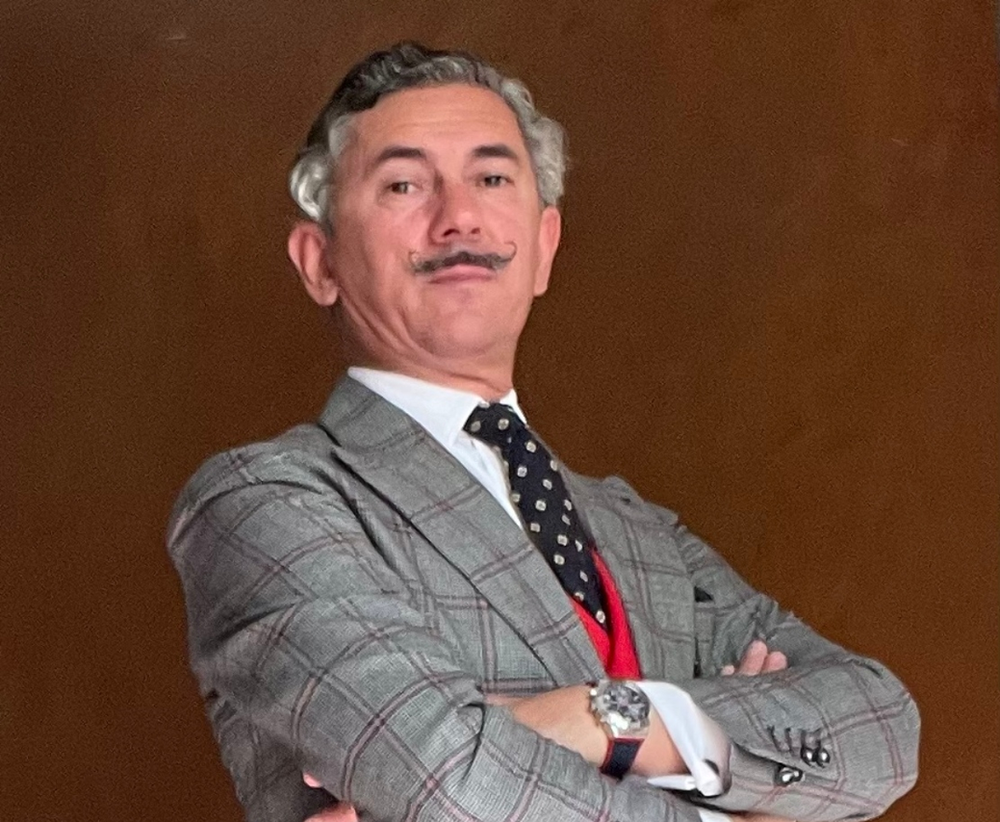
Paulo Saraiva Da Silva
L’indole di ciascun individuo si manifesta a volte inconsapevolmente nel momento in cui viene intrapreso un percorso che sembra essere quello più affine alle proprie caratteristiche, salvo poi dover prendere atto di altre forti inclinazioni che trovano il modo di farsi sentire, di emergere alla coscienza e di trovare il giusto collocamento all’interno dell’esistenza di chi ne è protagonista. Paulo Saraiva Da Silva percepisce presto la tua tendenza all’innata curiosità che lo spinge a confrontarsi e misurarsi in diversi settori, in alcuni casi completamente divergenti tra loro, e a seguire il suo istinto verso la conoscenza, il viaggio, la scoperta che lo induce a effettuare percorsi ed esperienze in città diverse da quella di origine. Nato in Portogallo, nella città di Possacos dove studia Agronomia, sperimenta e lascia spazio alla sua natura creativa dedicandosi alle scenografie teatrali, di cui ha realizzato la messa in scena di diverse rappresentazioni per l’Associazione Culturale e Sportiva di Possacos, ruolo che ha ricoperto per ben quattordici anni; nel frattempo si era già trasferito a Parigi per intraprendere gli studi di Architettura, Decorazione e Cultura Francese, mentre cominciava a perfezionare la sua tecnica pittorica frequentando i corsi di Olivier Debre, professore alla Scuola Superiore di Belle Arti di Parigi. La sua dinamicità creativa e l’esperienza come scenografo teatrale, associate alla competenza professionale acquisita con il suo percorso di studi, lo hanno condotto a un’importante collaborazione con il Kennedy Center of Performances and Arts di Washington DC, nel dipartimento luci e allestimento del palco per la messa in scena delle opere teatrali. Ovviamente nell’arco di tutto questo tempo trascorso a sperimentare, conoscere e scoprire mondi diversi dal suo, ampliando la capacità di comprendere punti di vista e modi di lavorare diversi dal proprio e, di conseguenza, allargando il proprio campo di esperienza e di capacità empatica, si è sempre dedicato alla sua grande passione, quell’espressione pittorica attraverso la quale riesce a dare vita alle sue emozioni, alle sensazioni percepite dall’esterno immortalandone un istante che riesce ad amplificare e a trasformare in opera d’arte. La sua produzione artistica si muove in un terra di mezzo tra Espressionismo e Surrealismo poiché la forte presenza della componente simbolica, densa di significati da esplorare e su cui riflettere, lo avvicina a quei processi mentali e onirici, a quella tendenza ad andare oltre il visibile e il significante tipica delle tematiche surrealiste; d’altro canto lo spiccato impatto emotivo, la tendenza a far prevalere le sensazioni sull’estetica della forma e la semplificazione della raffigurazione sono tutti elementi fortemente espressionisti.
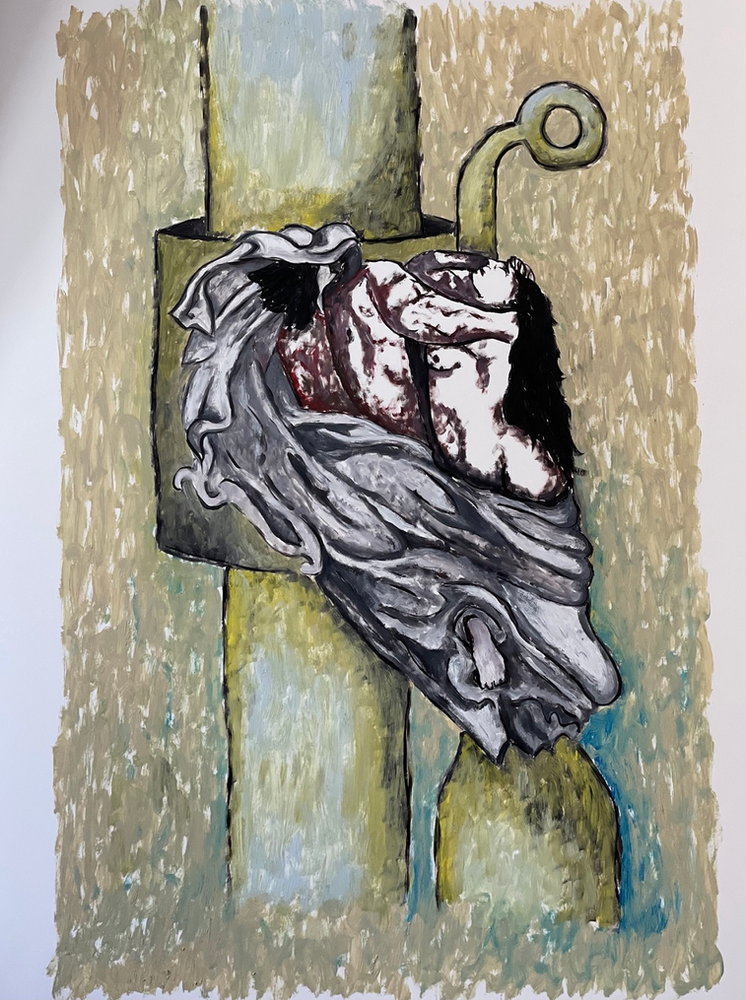
New rising (Nuova ascesa)
A conferma inoltre dell’eclettismo creativo di Paulo Saraiva Da Silva i suoi cicli pittorici, per la maggior parte realizzati con materiali di riciclo, si legano ai percorsi esistenziali che l’artista vive in prima persona e che osserva intorno a sé, oppure a progetti a cui sente di volersi dedicare per soddisfare la sua impellenza narrativa, che si tratti di emozioni oppure di interpretazione personale di qualcosa che colpisce la sua attenzione e il suo estro.
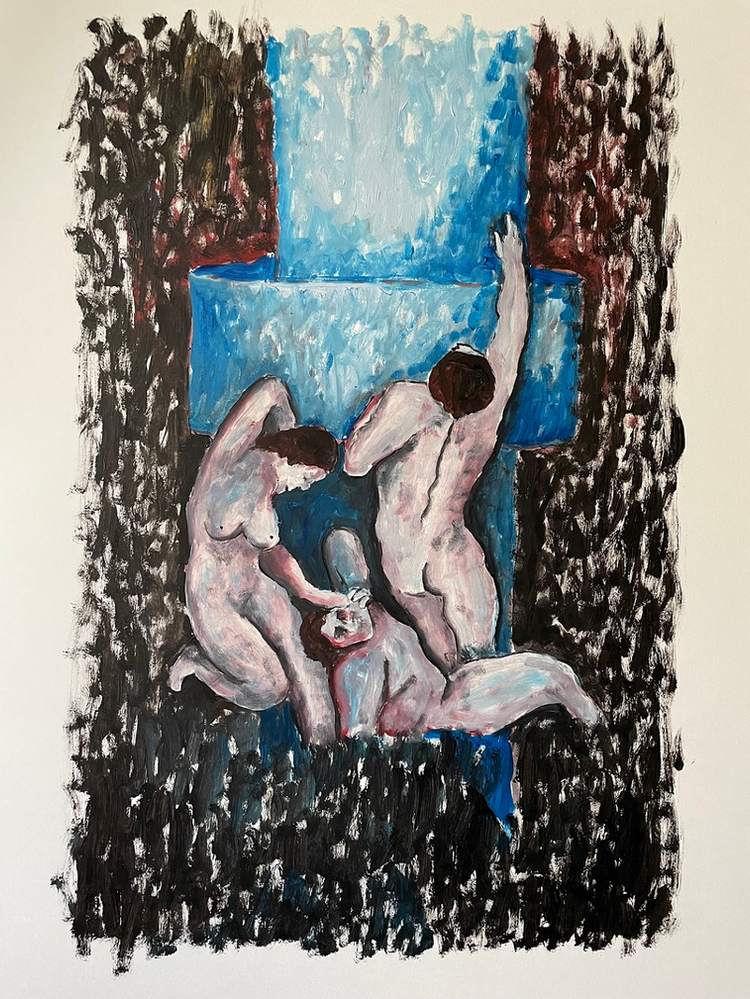
Up there (Lassù)
È questo il caso dell’ultima produzione in cui decide di dedicare diverse tele ai personaggi secondari della Divina Commedia di Dante Alighieri, personaggi di cui trasforma il momento della sofferenza e della disperazione in tensione ed esplorazione sensuale, erotica, come se in qualche modo l’artista volesse sottolineare quanto in fondo tutto, anche i momenti peggiori, possano essere tramutati e assumere un’accezione più positiva e piacevole, e quanto la capacità di adattamento alle situazioni che nell’esistenza si susseguono sia fondamentale a sviluppare la resilienza e la consapevolezza di potersi rialzare e trarre l’insegnamento positivo anche da una caduta. Oggi abbiamo l’opportunità di approfondire il mondo creativo di Paulo Saraiva Da Silva conoscendolo personalmente.
Lei ha avuto un’importante e duratura esperienza come scenografo teatrale, quanto ha contato questo suo percorso professionale nella sua carriera artistica e quanto sulla sua inclinazione a utilizzare materiali di recupero? Fa parte dell’improvvisazione scenica la capacità di trasformare o adattare gli oggetti in altro dal loro uso originale?
In effetti l’abitudine a gestire e modellare materiali di ogni genere per poi vederli successivamente riposti in un angolo senza alcun utilizzo… mi ha dato una spinta a riflettere su quanto fosse triste non poter dare loro l’opportunità di dargli un nuovo aspetto, una nuova vita per essere usati di nuovo e sotto una veste inedita. Sono fermamente convinto che ogni cosa o essere abbia diritto a seconde opportunità di esistere, anche seguendo la filosofia del riciclo necessario e benefico ai fini della conservazione del pianeta, dunque il mio punto di vista personale è divenuto un modo per aderire all’ideologia ecologica.
Delle tre città in cui ha vissuto, un po’ per scelta un po’ per lavoro, quale le ha lasciato il segno più profondo? Quale ha sentito più sua o in cui si è sentito più a suo agio?
Beh, Possacos è la mia città natale dove ho vissuto e sono cresciuto perciò lì mi sento a mio agio, mi sento a casa, ma per quanto riguarda il mondo artistico è un luogo non molto aperto poiché l’arte non rientra negli interessi della gente del posto. In virtù della mia forte indole creativa è stato necessario spostarmi per ampliare le mie conoscenze e la mia professionalità e sono andato a Washington DC che è una bella città ma abbastanza chiusa perché a meno che non si riesca a entrare a far parte di un giro di persone amichevoli e aperte di ha la sensazione di essere soli. C’è interesse verso l’arte plastica e l’accoglienza del pubblico è abbastanza positiva e gratificante ed esistono ancora veri galleristi che promuovono la conoscenza dei nuovi arrivati. E poi infine sono approdato a Parigi che è per me la città più bella del mondo dove l’arte abbonda in tutti i sensi, dal punto di vista dell’ispirazione artistica. Purtroppo l’affermazione di nuovi artisti è molto difficile perché ci sono pochissime Gallerie che svolgono effettivamente la loro funzione classica, si pongono piuttosto come mercanti d’arte perché se non sei conosciuto o noto nei loro ambienti non sei interessante a meno che non riesci a entrare a far parte di uno dei salotti che contano. Lisbona, invece è una città vivace e dinamica con forte interesse verso l’arte anche nei confronti degli emergenti.

Reaching the moon (Raggiungendo la luna)
La sua produzione artistica associa l’Espressionismo al Simbolismo surrealista, sebbene in alcune opere prevalga più il primo mentre in altre predomina il secondo: da cosa dipende questa alternanza? Dipende dai soggetti scelti o semplicemente dal suo impulso creativo?
Nelle mie opere ritraggo personaggi umani con forme e posizioni espressive, di forte impatto, a volte contorte su se stesse per narrare le emozioni che desidero imprimere sulla tela; le teste ad anello per esempio evocano la libertà di pensiero o una mente aperta. Spesso i miei personaggi sono circondati da forme più o meno circolari o colorate che evocano situazioni, sentimenti, e in base alla posizione in cui li pongo dominano o sono dominati dal soggetto. Perciò quando mi appresto a dare vita a un’opera inizio i tratti inconsciamente e allo stesso tempo per impulso, sviluppo un mondo surreale che esprime una situazione.
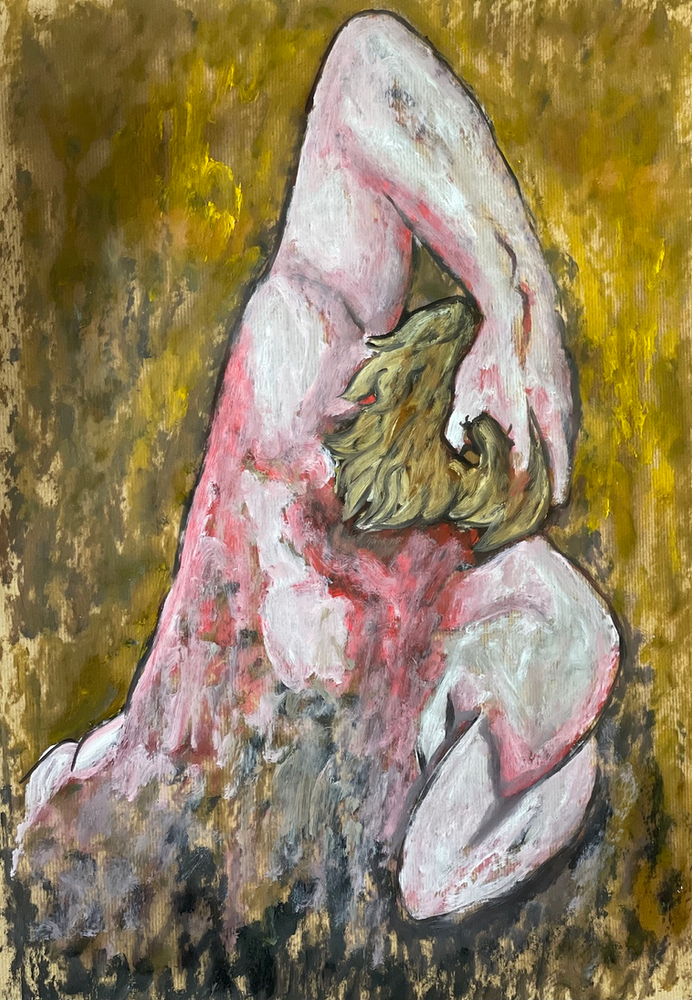
Giant rest (Il riposo del gigante)
Ci parla del nuovo ciclo pittorico dedicato alla Divina Commedia? Da cosa è stato ispirato e qual è il messaggio che desidera arrivi al pubblico?
La Divina Commedia è un soggetto che mi gira in testa da anni e ho impiegato molto tempo a meditare sulla sua realizzazione poiché non è facile concretizzare l’idea ispirata da un’opera così importante, unica e complessa come il capolavoro di Dante Alighieri. Ho deciso di concentrarmi sui personaggi secondari, trasportandoli dalla sfortuna, dalla sofferenza, dalle pene che venivano loro inflitte nel romanzo, verso un mondo migliore. Per esempio quando prendo dei personaggi da una scena dell’inferno dove i soggetti sono in disordine e li trasferisco nel mio mondo mio pittorico questi stessi personaggi diventano quasi erotici, come se volessi salvarli e trasferire il negativo in forza positiva, passionale. Il messaggio che cerco di lasciare è che in fondo non c’è bisogno di molto per cambiare la vita di qualcuno o qualcosa, basta essere capaci di cambiare il punto di vista o la direzione dell’energia che può modificare completamente il destino, il modo di vedere le cose. Il nome di questa serie è La vita è una commedia… Divina, da queste apparenze!
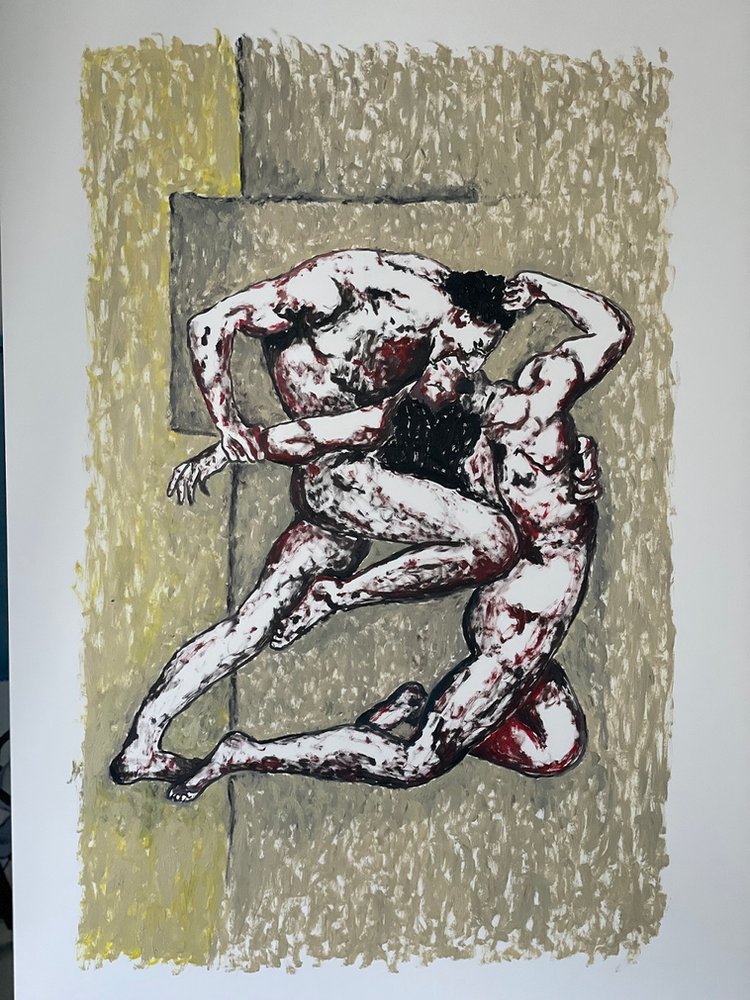
Hate or love (Amore od odio)
Stati Uniti, Francia, Italia, Danimarca, Portogallo, sono i paesi dove ha esposto le sue opere, paesi dove si trovano anche i suoi maggiori collezionisti; quali sono i suoi prossimi progetti? Dove sogna di esporre pur non essendovi ancora riuscito?
I miei maggiori collezionisti d’arte sono in Portogallo, è incredibile, non mi aspettavo che il popolo portoghese apprezzasse così tanto il mio lavoro. Per ora non ho ancora programmato la stagione invernale, piuttosto mi sto dedicando a dipingere le tele del mio grande progetto sulla Divina Commedia. In merito al mio sogno più grande è quello di esporre il mio lavoro a Parigi, ma è abbastanza difficile proprio per il fatto che in quella meravigliosa città se non si è già molto conosciuti si viene spesso snobbati. Tuttavia non smetterò di sognare questo obiettivo… e prima o poi lo raggiungerò.
PAULO SARAIVA DA SILVA-CONTATTI
Email: paulojssdc@gmail.com
Sito web: https://www.psilva-art.com/
Facebook: https://www.facebook.com/paulo.saraivadasilva.77
Instagram: https://www.instagram.com/saraiva75007/
Marta Lock’s interviews:
Paulo Saraiva Da Silva, the constant evolution of an artist
The nature of each individual sometimes manifests itself unconsciously when it is taken a path that seems to be the most similar to his own characteristics, except then have to take note of other strong inclinations that find a way to make themselves heard, to emerge to consciousness and to find the right place in the existence of those who are the protagonists. Paulo Saraiva Da Silva soon perceived his tendency towards innate curiosity, which drove him to confront and measure himself in different fields, in some cases completely divergent from each other, and to follow his instinct towards knowledge, travel and discovery, which led him to make journeys and experiences in cities other than his own. Born in Portugal, in the town of Possacos, where he studied Agronomy, he experimented and gave space to his creative nature by devoting himself to theatrical scenography, for which he staged several performances for the Cultural and Sports Association of Possacos, a role he held for fourteen years. In the meantime, he had already moved to Paris to undertake studies in Architecture, Decoration and French Culture, while he began to perfect his painting technique by attending the courses of Olivier Debre, a professor at the School of Fine Arts in Paris. His creative dynamism and experience as a theatrical set designer, combined with the professional expertise acquired through his studies, led him to an important collaboration with the Kennedy Center of Performances and Arts in Washington DC, in the lighting and stage design department for the staging of plays. Obviously, during all this time spent experimenting, getting to know and discovering worlds other than his own, expanding his ability to understand points of view and ways of working different from his own and, consequently, broadening his field of experience and empathic capacity, he has always devoted himself to his great passion, that pictorial expression through which he manages to give life to his emotions, to the sensations perceived from the outside, immortalising an instant that he manages to amplify and transform into an artwork. His artistic production moves in a middle ground between Expressionism and Surrealism, since the strong presence of the symbolic component, full of meanings to explore and reflect upon, brings him closer to those mental and oneiric processes, to that tendency to go beyond the visible and the significant typical of Surrealist themes; on the other hand, the strong emotional impact, the tendency to let feelings prevail over the aesthetics of form and the simplification of the representation are all strongly Expressionist elements. Moreover, Paulo Saraiva Da Silva’s creative eclecticism is confirmed by the fact that his cycles of paintings, most of which are made from recycled materials, are linked to the existential paths that the artist personally experiences and observes around him, or to projects that he feels he wants to pursue in order to satisfy his narrative urge, whether these are emotions or a personal interpretation of something that strikes his attention and his inspiration. This is the case of his latest production in which he decided to devote several canvases to the secondary characters of Dante Alighieri’s Divine Comedy, characters whose moment of suffering and despair he transforms into tension and sensual, erotic exploration, as if in some way the artist wished to emphasise how everything, even the worst moments, can be a source of inspiration, even the worst moments, can be transformed and taken on a more positive and pleasurable meaning, and how the ability to adapt to the situations that follow one another in existence is fundamental to developing resilience and the awareness of being able to get back up and draw positive lessons even from a fall. Today we have the opportunity to delve into the creative world of Paulo Saraiva Da Silva by meeting him personally.
You had an important and long-lasting experience as a theatre set designer, how much did this professional path count in your artistic career and how much did it influence your inclination to use recycled materials? Is the ability to transform or adapt objects into something other than their original use part of stage improvisation?
In fact, the habit of handling and shaping materials of all kinds only to see them put away in a corner without any use… gave me a push to reflect on how sad it was not to be able to give them a new look, a new life to be used again and in a new guise. I firmly believe that every thing or being has the right to a second chance to exist, even following the philosophy of necessary and beneficial recycling for the preservation of the planet, so my personal point of view has become a way to adhere to the ecological ideology.
Of the three cities in which you have lived, partly by choice and partly by work, which one has left the deepest mark on you? Which one did you feel most at home in or in which you felt most at ease?
Well, Possacos is my hometown where I lived and grew up so I feel comfortable there, I feel at home, but as far as the artistic world is concerned it is not a very open place because art is not in the interests of the locals. Because of my strong creative nature I had to move to expand my knowledge and my professionalism and I went to Washington DC which is a nice city but it’s quite closed because unless you can get into a circle of friendly and open people you feel you are alone. There is interest in plastic art and the public reception is quite positive and gratifying and there are still real gallery owners who promote the knowledge of newcomers. And then finally I landed in Paris, which for me is the most beautiful city in the world where art abounds in every sense, from the point of view of artistic inspiration. Unfortunately, the affirmation of new artists is very difficult because there are very few galleries that actually carry out their classic function; they are more like art dealers, because if you are not known or well-known in their circles, you are not interesting unless you manage to become part of one of the salons that count. Lisbon, on the other hand, is a lively and dynamic city with a strong interest in art, including emerging artists.
Your artistic production associates Expressionism with Surrealist Symbolism, although in some works the former prevails while in others the latter predominates: what does this alternation depend on? Does it depend on the subjects chosen or simply on your creative impulse?
In my artworks I portray human characters with expressive shapes and positions, with a strong impact, sometimes twisted on themselves to narrate the emotions I wish to imprint on the canvas; the ring-shaped heads for example evoke freedom of thought or an open mind. Often my characters are surrounded by more or less circular or coloured shapes that evoke situations, feelings, and according to the position in which I place them they dominate or are dominated by the subject. So when I am about to give life to a work I start the lines unconsciously and at the same time by impulse, I develop a surreal world that expresses a situation.
Can you tell us about the new cycle of paintings dedicated to the Divine Comedy? What inspired it and what message do you want to get across to the public?
The Divine Comedy has been on my mind for years and it took me a long time to think about its realisation, because it is not easy to realise the idea inspired by such an important, unique and complex work as Dante Alighieri’s masterpiece. I decided to focus on the secondary characters, transporting them from their misfortune, suffering, the punishments inflicted on them in the novel, to a better world. For example, when I take characters from a scene in hell where the subjects are in disarray and transfer them into my pictorial world these same characters become almost erotic, as if I wanted to save them and transfer the negative into positive, passionate strength. The message I am trying to leave behind is that in the end you don’t need much to change someone’s life or something, you just need to be able to change the point of view or the direction of the energy that can completely change destiny, the way you see things. The name of this series is Life is a comedy… Divine, from these appearances!
The United States, France, Italy, Denmark and Portugal are the countries where you have exhibited your artworks, countries where your major collectors are; what are your next projects? Where do you dream of exhibiting, even though you have not yet managed to do so?
My biggest art collectors are in Portugal, it is incredible, I did not expect the Portuguese people to appreciate my work so much. For now, I have not yet planned the winter season, rather I am devoting myself to painting the canvases of my big project on the Divine Comedy. My biggest dream is to exhibit my artworks in Paris, but it is quite difficult because in that wonderful city, if you are not already well known, you are often snubbed. However, I will not stop dreaming of this goal… and sooner or later I will achieve it.
PAULO SARAIVA DA SILVA-CONTATTI
Email: paulojssdc@gmail.com
Sito web: https://www.psilva-art.com/
Facebook: https://www.facebook.com/paulo.saraivadasilva.77
Instagram: https://www.instagram.com/saraiva75007/
